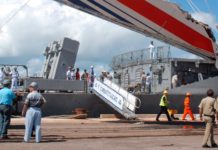• Congressional committees are holding hearings today dealing with federal oversight of the aviation industry, including how Boeing’s 737 Max plane, which has been involved in two deadly crashes, was certified.
• The crashes have raised questions about a new automated flight control system on the plane.
• They have also brought renewed attention to the relationship between the Federal Aviation Administration and companies it regulates, like Boeing.
• Boeing executives will meet with about 200 pilots, airline executives and regulators in Renton, Wash., to review proposed changes to the 737 Max.
[Sign up for With Interest, a Sunday newsletter to catch you up and prep for the coming week in business and tech news.]
Senators convene in the East and industry leaders in the West
The busy day on Capitol Hill began at 10 a.m. when the Senate Appropriations Committee’s transportation subcommittee convened a hearing with Transportation Secretary Elaine Chao. The hearing was ostensibly about the Transportation Department’s budget request for the 2020 fiscal year, but the session offered lawmakers an opportunity to question her about the 737 Max.
“I expect many of us to have questions for the secretary on F.A.A.’s relationship with Boeing and the government’s role in ensuring the safety of the traveling public,” Senator Susan Collins, Republican of Maine and the subcommittee’s chairwoman, said at the start of the hearing.
Ms. Chao addressed the subject in her opening statement.
“Let me emphasize that safety is always No. 1 at the Department of Transportation, and a good day is when nothing bad happens,” she said. Ms. Chao added of the this month’s Ethiopian Airlines crash in which 157 people died, “We all have a lot of important questions about this accident.”
At 3 p.m., the Senate Commerce Committee’s aviation subcommittee will hold a hearing on aviation safety, with a focus on the recent crashes. Scheduled to testify are Daniel K. Elwell, the F.A.A.’s acting administrator; Robert L. Sumwalt, the chairman of the National Transportation Safety Board; and Calvin L. Scovel III, the Transportation Department’s inspector general.
There is also plenty of activity planned at Boeing’s offices in Renton. The company, which initially had little to say about the crisis it’s been dealing with, will hold an early-morning briefing for reporters, followed by a factory tour. Later in the day, Boeing executives — though not the chief executive, Dennis A. Muilenburg — will meet with about 200 pilots, airline executives and regulators to review proposed changes to the 737 Max.
Two accidents raise safety questions
In October, Lion Air Flight 610 crashed just minutes after taking off from Jakarta, Indonesia, killing 189 people. Then, on March 10, Ethiopian Airlines Flight 302 also crashed minutes after takeoff, killing everyone on board. Both accidents involved Boeing’s 737 Max 8 jets. Investigations into both crashes are continuing, but preliminary flight data and other evidence have suggested similarities between the two accidents. Investigators are examining whether an automated system designed to help the plane avoid stalling may have been partly to blame.
The planes are grounded
In the days after the Ethiopian accident, global regulators grounded the jets. Those in China were the first to do so, and other governments around the world quickly followed suit.
While the planes are grounded, Boeing is working on a software update that would change the way the system suspected in the crashes operates. The company is also working on outlining new training procedures for pilots who fly 737 Max planes, and will retrofit jets with a safety feature that was previously optional. The feature will be standard on new Max planes.
How did the system come to be?
Boeing developed the 737 Max as the latest move in its rivalry with Airbus, the European plane manufacturer. When Airbus announced a more fuel-efficient version of its A320, the main competitor to the 737, Boeing risked losing major customers like American Airlines if it didn’t develop its own more fuel efficient planes.
In order to respond to Airbus’s new plane as quickly as possible, Boeing decided to update its popular 737 instead of designing a new plane from scratch. To make the 737 more fuel efficient, Boeing gave it bigger engines. However, that update changed the plane’s aerodynamics and made it prone to stall in certain conditions.
To reduce the risk of stall, Boeing developed a software system that became known as MCAS. It made the 737 Max fly more like previous versions of the plane, but pilots were not explicitly informed about how it worked.
The F.A.A.’s regulatory practices face scrutiny
The F.A.A. has long allowed plane makers to help certify that their new aircraft meet safety standards. That system is coming under increased scrutiny in light of more information about how closely Boeing worked with regulators on the 737 Max.
Source : Nytimes













